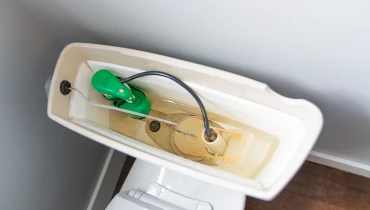
The modern-day toilet is a mystery to most homeowners. You probably never stop to think about how your toilet tank works—that is, until it stops working. Then, you may find yourself peering inside the tank with some fear and trepidation, hoping to make sense of all the components.
From the flushing process to the tank refill, we’ve got the details to help you make sense of it all.
What’s Inside a Toilet Bowl Tank?
The toilet tank creates the siphoning action necessary to wash away waste during the flushing process. Here are the components you’ll see inside a toilet bowl tank that make the flush happen:
- Handle: Pressing the handle on the tank begins the flush process.
- Handle Arm: This component inside the tank pivots when the handle is pressed.
- Chain: The handle arm yanks on the chain and lifts the flapper.
- Flapper: This rubber component, also known as the flush valve seal, falls against the flush valve drain opening, sealing it after each flush.
- Flush Valve: This part that is connected to the flapper and holds the rubber seal open, allowing water to flow into the toilet bowl.
- Drain Opening: The opening between the toilet tank and the toilet bowl.
- Fill Valve: Refills the toilet tank with fresh water before the next flush.
- Refill Tube: The rubber tube that takes water from the fill valve to the overflow tube of the flush valve to refill the toilet bowl.
- Filler Float or Float Ball: Depending on the model, a toilet will have either a filler float or float ball attached to the fill valve. They make the valve turn on the water once the tank is empty and turn off the water when the tank is full.
- Overflow Tube: This component serves two purposes:
1. Acts as a failsafe if the float ball comes loose or the filler valve malfunctions, preventing a tank overflow by redirecting extra water into the toilet bowl.
2. The refill tube connects to the overflow tube to refill the toilet bowl.
How Does a Toilet Flush?
With so many components in play, it’s easy to see how something can go wrong during the flushing process. However, when the toilet tank parts are working correctly, the flushing process is efficient and effortless. Once you press the handle, the handle arm raises up and lifts the chain, which then opens the flapper, activating the flush valve. The result is water rushing into the bowl by way of the drain opening. The water then washes any waste out of the bowl and down the main drain.
How the Tank Refill Process Works
The toilet refills when the filler float or float ball lowers as the tank empties. This signals the fill valve to turn on the water, which pours back into the tank through a refill tube. Simultaneously, the flapper seals the drain opening to prevent the fresh water from going into the toilet bowl. Once enough water is in the tank to get the filler float or float ball to rise to the set level, the tank stops filling.
Choose Mr. Rooter® Plumbing When Toilet Trouble Strikes
If your toilet components are not working correctly, you’ll notice right away. Your best course of action is to call your local Mr. Rooter Plumbing for professional toilet plumbing services from experienced and licensed plumbers. With upfront flat rate pricing and no overtime charges, Mr. Rooter Plumbing gets your toilet operating optimally without breaking the bank. Call us today to schedule an appointment or request an estimate online.

